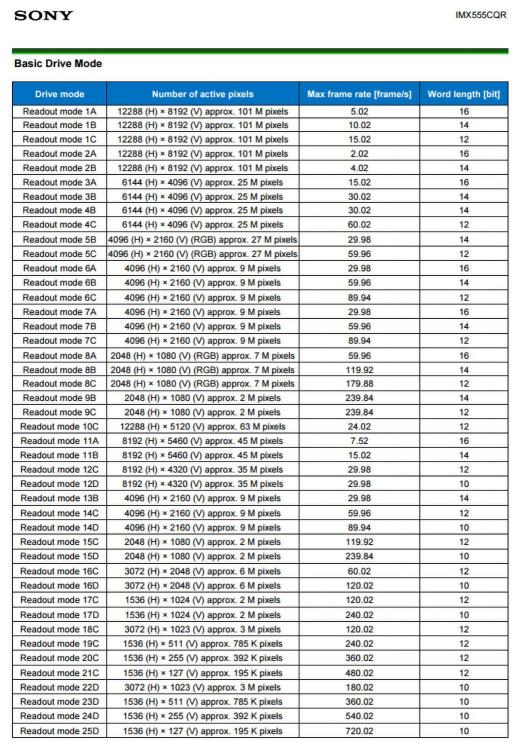
androidlad
Members-
Posts
1,215 -
Joined
-
Last visited
Content Type
Profiles
Forums
Articles
Everything posted by androidlad
-
Proper HDR displays can't be low cost due to them having to use Full Array Local Dimming backlight, or just OLED panel.
-
No. Global reset: Global shutter: Rolling shutter:
-
Recent correspondence from Metabones:
-
Short answer: no it will not, or shall we say, it does not ? Long answer: Quad Bayer is a cost-effective compromise to boost low light performance by dropping resolution by 4 times. What if I tell you there are more sophisticated technologies to achieve unparalleled low light performance while still maintaining high resolution? We can have designs such as Deep Trench Isolation (DTI), Pyramid Surface Diffractor (PSD) and colour-aware ADC, they address crosstalk, QE and read noise which are key metrics for low light performance.
-
No. I've confirmed with industry sources that the so-called 8K video is "AI upscaled" from regular 4K capture. Also the so-called "1920fps" slow-motion mode is also "AI interpolated" from 960fps.
-
No errors so far. Did you follow the instructions? The new firmware has been released on Swit website: http://www.swit.cc/CM-55C-firmware.aspx
-
DR400 is a 2 stop push from ISO160, that's why it starts with ISO640. DR200 1 stop push from ISO160.
-
It's not like that. DR100 film simulations let you use base ISO160, this is the native ISO with a video gamma that limits dynamic range, but ProNeg Std is the flattest of all film simulations. DR400 film simulations start at ISO640 and behave similarly to F-log, which actually expose at ISO160 and push shadow 2 stops. DR400 film simulations have similar DR with F-log (minor difference in roll-off), especially with highlights/shadow set to -2.
-
1000nit is barely enough and can still be difficult to see when the sun is hitting the screen directly, use a high quality deep sunhood. Swit will release a 3000nit 7inch model CM-S75C that's about $450.
-
Yes, doesn't matter for post-production. We use HLG as an alternative log profile. BT.2020 matrix coefficients tag is required for HDR playback, or on-the-fly conversion for SDR playback. This is why in Scratch, X-T3 HLG files are default blown-out (on an SDR display) because Scratch respects the tags. If we change the decoding parameter to BT.709 SDR, the images return to the flat look as seen on camera. Premiere ignores the tags and decodes everything in BT.709, so HLG files have that flat look ready for grading.
-
In Resolve, data/video level is arbitrary really, it's easily selectable in "Levels" clip setting. There's no need to use a LUT for that. Also it's not really a problem for external ProRes for HLG to contain all BT.709 tags. HLG/BT.2020 tags are required for instant HDR playback on end user devices, or for automatic HDR to SDR conversion. Doesn't matter for post-production. Alexa Log-C ProRes carry all BT.709 tags as well, ARRI has to put additional metadata field to say it's Log C.
-
The Swit can be powered directly from a compatible power bank via micro USB (minimum 2A current, 5V voltage). There's no internal battery.
-
Smallrig is making a purpose-built holder for power banks: https://www.smallrig.com/smallrig-holder-for-portable-power-banks-bub2336.html If you replace your monitor with Swit CM-55C, you can power it via micro USB.
-
Replace the fluorescent bulb with either Halogen or high CRI LED ones that are dimmable. Even the highest quality fluorescent lights have spiky and discontinuous spectrum. And most importantly they are not dimmable. When illuminating faces, light quality in terms of smooth and continuous spectrum is the key.
-
HLG Footage in Premiere Pro looks different than 2 versions ago
androidlad replied to BjornT's topic in Cameras
Nothing of concern here. Premiere does that to Alexa Log C footage as well, it automatically applies a BT.709 LUT. It's just now started doing it to HLG footage. Can be easily disabled with two clicks. -
HLG Footage in Premiere Pro looks different than 2 versions ago
androidlad replied to BjornT's topic in Cameras
It's the automatic HLG to SDR conversion triggered by metadata. Right click the clip(s), "Disable Masterclip Effect" -
Controlling camera parameters and most importantly, pulling focus on Fuji native lenses via USB, require some complicated "reverse engineering". Interestingly, a Timelapse tool VIEW did it a few months ago: https://www.newsshooter.com/2018/12/24/timelapse-view-intervalometer-is-now-compatible-with-fujifilm-x-series-cameras/ It allows full control over most Fuji X cameras.
-
DJI "officially announced" in a forum post by staff account that Ronin S will support X-T3 via a future firmware update. Regarding X-T2 and X-H1, they are "not sure". https://forum.dji.com/thread-151303-2-1.html
-
@Attila Bakos Fujifilm Tokyo has responded to the use of BT.601 tag in internally recorded files: ¯\_(ツ)_/¯
-
1. Signal format displays 59.94 instead of 60. 2. Default color temperature changed to “Native” 3. Signal format display and battery info display can be individually turned on/off. 4. User LUT supports 33x33x33 format upload 5. Add “Saturation” adjustment in calibration menu. 6. Fixed other bugs. Tool: SD card, FAT32
-
Sony Semicon develops 100MP FF sensor with 6K video
androidlad replied to androidlad's topic in Cameras
It has many lower resolution versions - within itself, by binning (2x2, 3x3, 4x4, 6x6) -
Sony Semicon develops 100MP FF sensor with 6K video
androidlad replied to androidlad's topic in Cameras
Let's all marvel at this particular piece of cutting edge engineering. It's the one sensor to rule them all. There's 8K 30P, 6K 60P, 4K 90P, 3K 120P, 2K 240P. Ultra high sensitivity RGB binning mode is available for 4K up to 60P and 2K up to 180P. 16bit ADC readout is available for video framerates for the first time.

